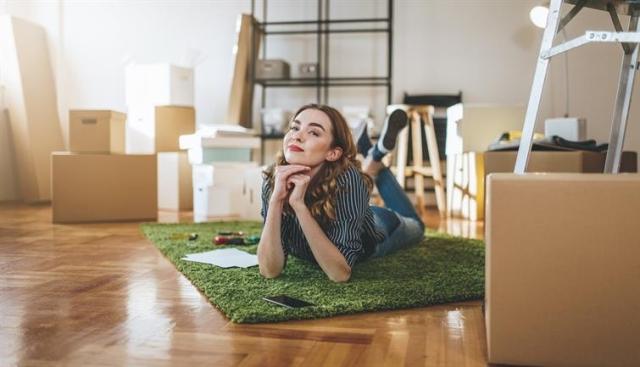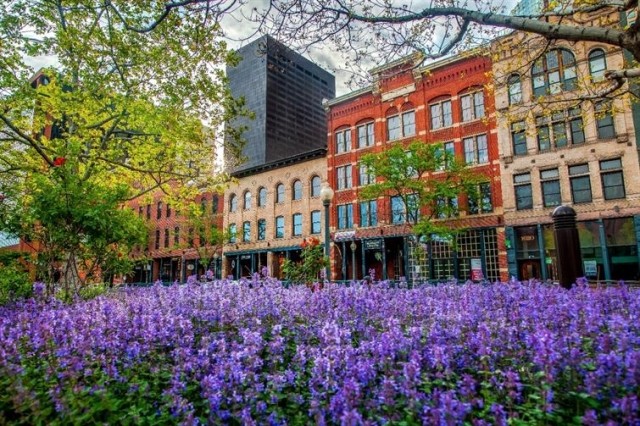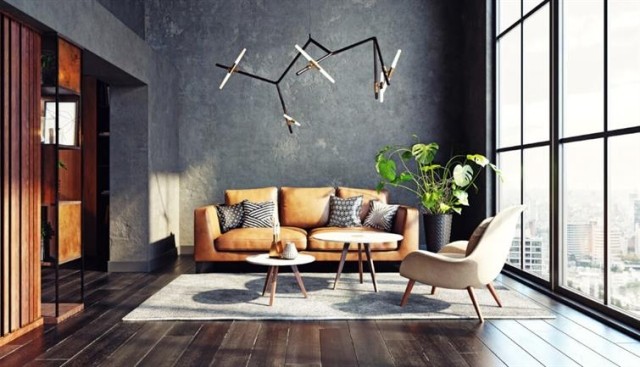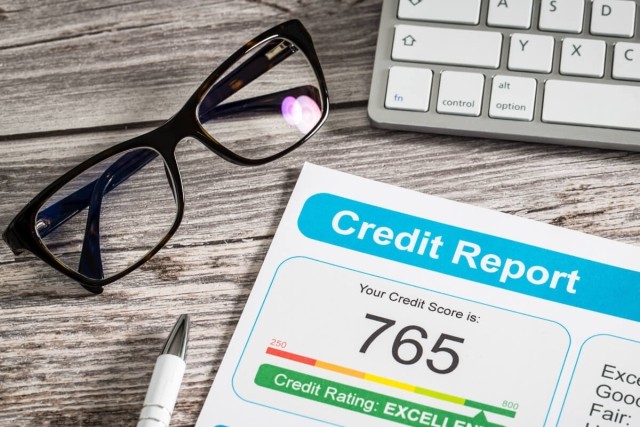When you move to your very first apartment, you’ll likely get tons of tips and advice, and maybe even some hand-me-down furniture from your Great Aunt Edna. (Don’t worry, that orange flowered sofa will look great in your new place!) But what do you really need to know? Let’s review the whole process, beginning with the apartment search.
The Apartment Search
How hard could this part be? You just find a place and move in, right? Well, not so fast. As you start looking for apartments, you may begin to feel a little overwhelmed. There’s so much to consider! For example, where do you want to live? What amenities do you want? How much can you afford to pay every month? Do you want a studio, a one-bedroom, or a two-bedroom apartment? Never fear! We have apartment-renting tips to cover all of these questions.
Your apartment location
Location is very important when searching for apartments. You’ll want to consider your commute to work or school, as well as proximity to things you enjoy (state parks or hiking trails, restaurants and bars, nail salons and boutiques … whatever they may be). Here are more things to consider:
- If you prefer to drive, how is the traffic at rush hour?
- If you prefer to take public transportation, is there a bus or train station nearby?
- If you like to bike or walk to work or school, are there sidewalks and bike lanes?
If you can rent in a neighborhood that’s somewhat close to a friend or family member, consider doing so, especially if you’ll be living alone for the first time. Knowing that person is a short drive away will help you feel a little more secure. Just don’t rent too close. If you are only around the corner from your parents, for example, you can expect a lot of pop-ins. If your family and friends have to drive several minutes to get to you, they’ll be more likely to call first to make sure you’re at home.
Think about where you are when you feel the most comfortable and relaxed. Do you feel at home in the heart of the city, with the sounds of traffic lulling you to sleep? Or do you prefer getting away from it all, where all you can hear are the crickets chirping? This will help you decide whether a neighborhood is right for you. If crowds and traffic bother you, then don’t move to a downtown neighborhood, even if it’s considered the trendy place to live. You’ll likely be happier in a suburban community where you can get to the city for the fun and events but have a quieter place to return home. The opposite is also true: if you don’t like quiet, subdued surroundings, then don’t move to a rural or suburban community.
There’s another big factor to choosing a location: affordability. You may want to live in the most sought-after, trendy neighborhood in the city, but those prime locations come with a prime price tag. The more people competing for a limited number of available rentals, the higher the cost will be. If you can’t afford the neighborhood, try looking in surrounding areas with cheaper rents or consider getting a roommate to share the costs with.
Apartment amenities
Amenities are a major perk of apartment living. After all, having an on-site fitness center and maybe even a swimming pool are great features! But top amenities and features like these could mean higher rent.
As you look at apartments, consider which amenities are truly necessary. For example, if you have a pet, then a pet-friendly policy would be a must-have amenity. Do you want an in-unit washer and dryer? Is that more important than other features, like an on-site gym? Make a list of your must-haves, then a list of your wants. Use online search filters to find your must-have amenities since these are your deal-breakers. Hopefully, you’ll find a place with all your must-haves and a few of your wants that’s still within your budget.
Your apartment budget
If you haven’t determined your budget yet, you need to do this right now. Open a spreadsheet and we’ll walk through this together.
- Enter the amount of your paycheck. This is your net income, which is different from your gross income (that’s your salary before taxes and deductions).
- Go line by line and enter all your monthly expenses and bills that you currently pay (student loans, car payment, car insurance, credit cards, your phone bill, monthly subscriptions, etc.)
- Think about what you’ll need to pay when you move to your own place. You’ll want to consider things like renters insurance, groceries, and transportation costs.
- Add the average cost for utilities, unless you plan on renting an all-utilities-paid apartment. Consider electric, gas, water, garbage, and internet.
- Determine how much you need for discretionary expenses every month (discretionary expenses are non-essential things like entertainment, dining out, new shoes, trips to the hair salon, etc.).
- If you want to save a certain amount each month, add that in as well.
Deduct all your expenses from your net income, and this is how much you should spend on rent. (You can also determine this using the 50/30/20 rule, where 50 percent of your budget is for everything you need like rent, food, and bills; 30 percent of your budget is for wants, like shopping and dining, and 20 percent is for savings.
Choosing the right apartment size
Now that you’ve planned a budget and know how much you can comfortably spend on rent, that three-bedroom in the heart of the city may be looking a bit out of reach. But did you really need all that space? How do you decide the right apartment size?
If you rent an apartment that’s too small, you might feel a bit cramped. At the same time, you don’t want to pay for space you won’t use. Keep this in mind: you’re paying by the square foot, so the larger the apartment, the more you’ll pay. If you don’t use the second bedroom for anything but a place to keep your bike and toss laundry when family members drop by unexpectedly (perhaps you should have moved another mile or two away), you’re paying for that unused space.
Utilities will increase along with the size of the apartment, so keep that in mind if you’ll be on a tight budget. The larger the space, the more it will take to heat and cool it. While that ultra-hip loft with soaring ceilings and historic brickwork is amazing, all that unused space above your head will have to be heated and cooled (floor-to-ceiling windows will also mean higher utility bills).
Layout is more important than size, so try to find a layout that works for you. If you need storage, make sure the apartment has plenty of closet and cabinet space, or look for an apartment with additional outside storage.
Apartment Applications, Fees, and Other Charges
Renting an apartment is expensive. You’ll need enough money to cover the application fee, the first month’s rent (and perhaps the last month’s, as well), the security deposit, administration fees, and if you are moving into your apartment with a pet, you might have to pay a pet deposit. You’ll also need enough money to pay utility deposits, parking and storage fees, and moving fees. As a rule of thumb, take your monthly rent amount and triple it — this should give you enough to cover your moving expenses.
You’ll want to get renters insurance if you don’t have it. Renters insurance protects your belongings from fire or theft, and it covers your liability if a visitor is injured in your apartment. It may also cover temporary housing if your apartment is damaged in a storm or a fire. Some apartment communities require renters insurance, but even if you find a rental that doesn’t, it is probably worth getting anyway (and most renters insurance plans are inexpensive).
Unless you have a pick-up truck, or everything you own fits in the trunk of your car, you will probably need to hire movers or rent a moving truck. Depending on the size of the truck and the distance you’ll be traveling, this could cost anywhere from $50 to $2,000. If you hire a moving company, that could cost anywhere from $1,000 to $10,000 if you are moving across the country.
Other costs associated with moving include food (you’ll probably want to order takeout the first night since you’ll be tired from moving and everything will still be in boxes), cleaning supplies, and basic essentials like paper towels, toilet paper, and soap.
Your Apartment Move-In Day
While moving into your first apartment is exciting, there are some steps you need to take before you load in any furniture or boxes. Before moving in, conduct a walk-through with your property manager or landlord. If you don’t do this, it could impact your ability to get your security deposit back when you move out. Photograph every dent, scratch, and stain you see. If there are any leaks or if anything is broken, make note of it on your walk-through checklist. Sign and date this with your property manager.
Check the following for signs of damage:
- Floors
- Walls
- Cabinets
- Appliances
- Windows
Email any photos and videos you take during the walk-through to your property manager or landlord immediately afterward. Save these photos and videos. When you move out, you’ll do another walk-through. You’ll be able to compare the condition to make sure you aren’t charged for any preexisting damage.
First Apartment Checklist
Renting your first apartment is exciting and you might want to fill your new space with fantastic décor and elegant artwork. But since moving was expensive, you might not be able to buy everything at once.
If you didn’t inherit a couch from your Great Aunt Edna, then you may need to buy some basic furniture. If you don’t have any dishes, you might need to purchase a few kitchen staples, as well. But while some things will be necessary immediately, other items can wait.
What you’ll need right away:
- A place to sleep (a bed, mattress, or futon … an air mattress or sleeping bag in a pinch)
- Something to sit on (a hand-me-down couch is just fine for now)
- Sheets (at least one set) and a blanket
- A pillow and a pillowcase
- Personal care items (glasses, contact solution, medications)
- Shampoo and conditioner
- Soap
- Paper towels
- Toilet paper
- Bath towels
- Vacuum cleaner/broom
- Trash bags
- Pantry staples (coffee, sugar, milk, cereal, etc.)
- Basic tools (screwdriver, hammer)
- Pet food, bowls, leash
Things you can add over time:
- Headboard
- Dining table and chairs
- Throw pillows
- Side tables
- Coffee table
- Artwork
- Rugs
- Plants
- Kitchen accessories/small appliances
- Lamps
- Shelves/bookcases
Moving into a new apartment is fun and exciting, but it can also be overwhelming. There’s a lot of prep work that goes into a successful move, but it’s well worth it in the end. First apartment challenge, accepted! Now, go find your new place.






